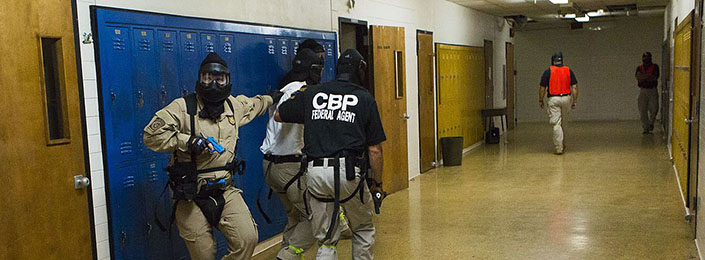
Situations involving a hostile intruder or a bomb threat leave little time to react. Understanding guidelines and making plan will help you know immediately what to do, if a situation occurs.
Jump to:
Hostile Intruder|Bomb Threat or Suspicious Package
Hostile Intruder
If you believe there is a threat, respond immediately as time is critical. The Department of Homeland Security recommends the following actions:
Be Informed. Request active shooter training for your student group, office or other college location by contacting the Office of Emergency Management. If you see something, say something immediately to Public Safety-Dispatch at 402-559-5111. Sign up for UNMC Alerts. Be aware of your environment and any possible dangers.
Make a Plan. Plan what you would do if confronted by an active shooter. Look for the two nearest exits anywhere you go. Have an escape path in mind, and identify places where you could hide. If you have a disability or other access and functional needs, contact the Office of Emergency Management for help with emergency planning and preparedness.
During
RUN and escape, if possible. Getting away from the shooter or shooters is the top priority. Leave your belongings behind and get away. Help others escape, if possible, but evacuate regardless of whether others agree to follow. Warn and prevent individuals from entering an area where the active shooter might be. Call 911 when you are safe and describe shooter, location and weapons.
HIDE, if escape is not possible. Get out of the shooter’s view and stay very quiet. Silence all electronic devices and make sure they won’t vibrate. Lock and block doors, close blinds, and turn off lights. Don’t hide in groups; spread out along walls or hide separately to make it more difficult for the shooter. Try to communicate with police silently. Use text messages or social media to tag your location, or put a sign in a window. Stay in place until law enforcement gives you the all clear. Your hiding place should be out of the shooter's view and provide protection if shots are fired in your direction.
FIGHT, as an absolute last resort. Commit to your actions and act as aggressively as possible against the shooter. Recruit others to ambush the shooter with makeshift weapons like chairs, fire extinguishers, scissors, books, etc. Be prepared to cause severe or lethal injury to the shooter. Throw items and improvise weapons to distract and disarm the shooter.
After
Keep hands visible and empty.
Understand that the first task of law enforcement is to end the incident, and officers might have to pass injured along the way. Officers may be armed with rifles, shotguns, and/or handguns and might use pepper spray or tear gas to control the situation. Officers will shout commands and might push individuals to the ground for their safety. Follow law enforcement instructions and evacuate in the direction they come from, unless otherwise instructed.
Take care of yourself first, and then you may be able to help the wounded before first responders arrive. If the injured are in immediate danger, help get them to safety. While you wait for first responders to arrive, provide first aid. Apply direct pressure to wounded areas and use tourniquets if you have been trained to do so.
Turn wounded people onto their sides if they are unconscious and keep them warm.
Consider seeking professional help for you and your family to cope with the long-term effects of the trauma.
Bomb Threat or Suspicious Package
Do not hang up if you receive a telephone bomb threat. Leave your phone off the hook when the call is over so the call can be tracedRemain calm. Try to prolong the conversation
Use a different phone to call 402-559-5555 to report the threatening phone call
If you find a suspicious package or envelope, contact Security/Public Safety Dispatch at 402-559-5555 and provide the location. Do not handle the package. Prevent others from further entering the area.

